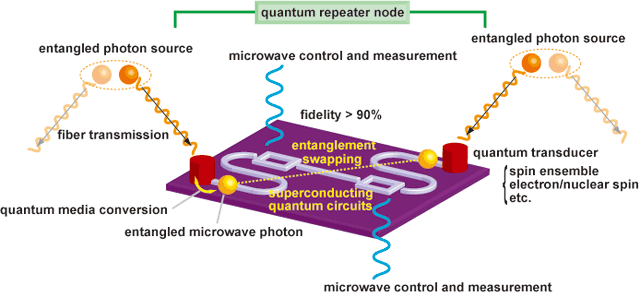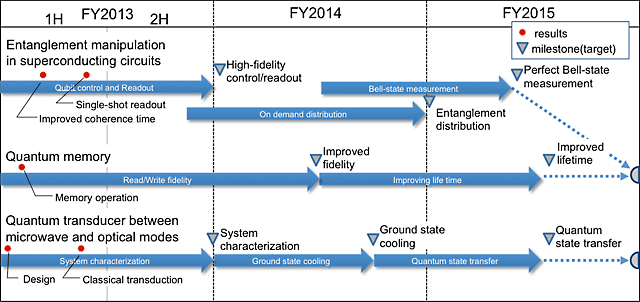
Subject C : Multi-bit entanglement control and optical interface with Superconducting circuits
158C-T01Superconducting circuit-QED and quantum transducer
The University of Tokyo (Yasunobu Nakamura)
Nippon Telegraph and Telephone Corporation
Tokyo Medical and Dental University
Tohoku University
Quantum repeater is an indispensable technology for constructing long-distance secure photonic network in the presence of finite loss in optical fibers. To distribute entanglement between remote parties, entanglement swapping operations at quantum repeater nodes in between are required. To this end, we are developing technologies based on superconducting quantum circuits hybridized with other quantum degrees of freedom. Our project is running along the following two subthemes.
- Subtheme 1: Superconducting circuits for entanglement manipulation
- The rapid progress on quantum information processing technology in superconducting circuits makes it promising for high-fidelity entanglement manipulation demanded in the quantum repeater applications. The recent improvement of the coherence time beyond 100 µs has boosted up the achievable gate fidelity. It also allows high-fidelity quantum nondemolition readout of qubits with an aid of low-noise devices in the quantum limit, such as Josephson parametric amplifiers. In the circuit quantum electrodynamics (circuit QED) architecture consisting of qubits and resonators, on-demand entanglement generation and Bell-state measurement for entanglement swapping are aimed at.
- Subtheme 2, 3: Quantum interface between superconducting circuits and other quantum mechanical systems
- Superconducting circuits work fine in the microwave domain. However, all the excellent properties are lost in the optical domain. Therefore, to interface quantum information in the superconducting quantum circuits with that in the optical communication network and vice versa, quantum transducer based on other quantum degrees of freedom is needed. The additional degrees of freedom need to couple with both microwave and optical modes coherently. The candidates include spin ensembles in solid, phonons in nanomechanics, and magnons in ferromagnets, for example. In such hybrid quantum systems, advantages from each system can be exploited to achieve the functionality.
- Quantum interface between superconducting circuits and other quantum mechanical systems is also useful for constructing quantum networks between superconducting quantum information processors as well as for quantum measurements with ultimate sensitivity. Our goal is to establish basic concepts and technologies versatile and robust enough for all such applications.

Fig. 1Superconducting circuits and quantum transducers for quantum interface between microwave and optical domains.
Interim results for Team 158C-T01
| Task title | Outcome | Date | Note |
|---|---|---|---|
| 1: Entanglement manipulation in superconducting circuits | Improved qubit coherence time and gate fidelity | Apr. 2013 | Phys. Rev. Lett. 110, 040502 (2013). |
| Λ-type three-level system as interface between microwave photon and qubit | Jun. 2013 | Phys. Rev. Lett. to be published | |
| Single-shot qubit readout using Josephson parametric amplifier | Aug. 2013 | Appl. Phys. Lett. 103, 132602 (2013). | |
| 2: Quantum interface between superconducting qubits and spins | Quantum memory operation: Storage and retrieval of an arbitrary quantum states in a spin ensemble in diamond | May. 2013 | Phys. Rev. Lett. 111, 107008 (2013). |
| 3: Quantum transducer between microwave and optical modes | Quantum transducer design based on collective modes in solids | Sep. 2012 | |
| Classical transduction between microwave and optical signals | Sep. 2013 |
Task 1 focuses on the development of necessary technologies for entanglement manipulation in superconducting circuits. We applied a low-noise Josephson parametric amplifier to the readout of superconducting qubits coupled to a microwave resonator. Single-shot quantum nondemolition readout was demonstrated. It also allowed continuous monitoring of the qubit states and observation of quantum jumps. By using careful pulse calibration and with an improved qubit coherence time, single-qubit gate fidelity >99% was achieved. We also proposed an use of Λ-type three-level system as an interface between a microwave photon and a qubit. Such Λ-system was realized in a driven superconducting circuits and was operated as a single-photon down-converter.
Task 2 achieved strong coupling between a superconducting flux qubit and an electron-spin ensemble of nitrogen-vacancy (NV) centers in diamond [Fig.2(a)]. Moreover, by reducing the defect density in the diamond and suppressing the effect of inhomogeneous broadening, the coherence property was improved. Quantum memory operation was demonstrated with the improved sample: An arbitrary quantum state prepared in the flux qubit was stored in and retrieved out from the spin ensemble. The read/write fidelity of 60% with the memory time of 20 ns was observed.
On Task 3, we have been investigating quantum transducers between microwave and optical modes. As candidates for the transduction media, we chose collective excitations in solid, such as phonons in nanomechanics and magnons in ferromagnets [Fig.2(b)]. Strong coupling between a magnon mode in a yttrium-iron-garnet (YIG) crystal and a microwave resonator was demonstrated down to a single magnon level. Magnon excitations were also probed by the Faraday effect at the telecommunication wavelength ~1.55 μm. Classical transduction of microwave to optical modes was demonstrated. We demonstrated coherent coupling between a classical microwave and a single photon using a single NV center in diamond.

Fig. 2(a) diamond crystal placed on a superconducting qubit,
(b) quantum transducer using magnon excitations in ferromagnet.
Targets for Team 158C-T01
| Task title | Work/Milestone | Due Date | Note |
|---|---|---|---|
| 1: Entanglement manipulation in super-conducting circuits | a) High fidelity qubit control and readout | Mar. 2014 | Target fidelity >99% |
| b) On-demand entanglement distribution | Mar. 2015 | ||
| c) Complete Bell-state measurement | Dec. 2015 | Target fidelity >95% | |
| 2: Quantum interface between super-conducting qubits and spins | a) Improved read/write fidelity | Sep. 2014 | Target fidelity >90% |
| b) Improved memory lifetime | Sep. 2015 | Target lifetime >10 μs | |
| 3: Quantum transducer between microwave and optical modes | a) System characterization | Mar. 2014 | |
| b) Ground state cooling of the transducer | Dec. 2014 | ||
| c) Quantum state transfer | Dec. 2015 |

Chart 1Schedule for Team 158C-T01